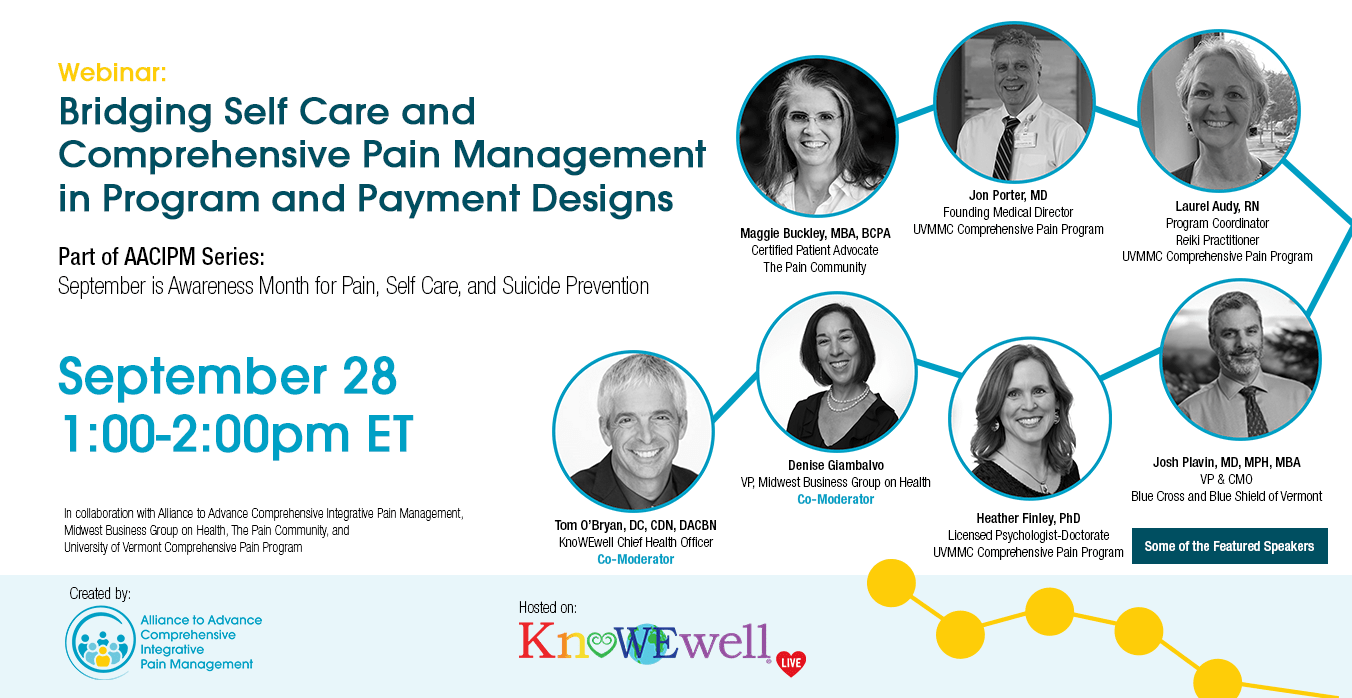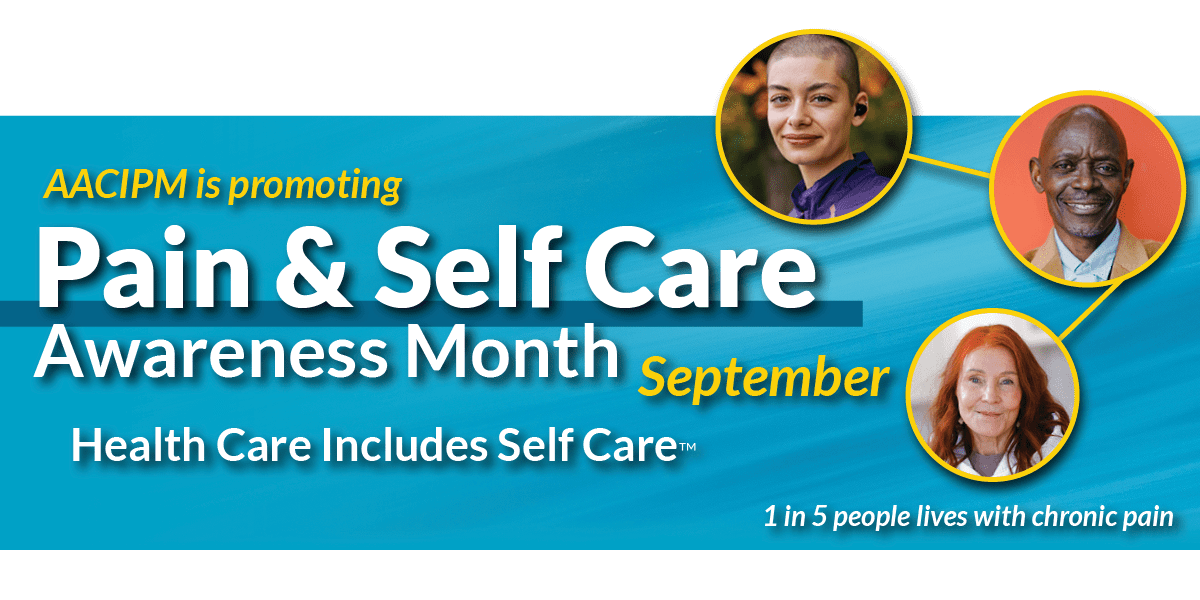
AACIPM is Promoting Pain and Self Care Awareness Month in September
Health Care Includes Self Care™
To promote both Pain Awareness Month and Self Care Awareness Month, AACIPM will be collaborating with many partners to spread awareness and deepen connections and understanding across the stakeholders.
Join us in our efforts to build awareness by registering for the webinars included within this newsletter, by sending us relevant resources on pain and self care for our repository, and by sharing the information (more to come soon!) with your interested networks.
We’ll be participating in IM4US 2021 Conference on September 24, co-moderating an amazing panel of people making positive differences in the lives of people who are underserved. We’ll share more details in coming issues about our presentation Advancing Integrative Pain Management Through Collaboration and Advocacy.
We have also developed a webinar, Bridging Self Care and Comprehensive Pain Management in Program and Payment Designs, to be held on September 28 from 1-2pm ET (free registration). Read the summary below for more information about this important webinar designed in collaboration with Midwest Business Group on Health, The Pain Community, and University of Vermont Comprehensive Pain Program hosted on KnoWEwell Live.
Also, to keep connecting those dots, read Duke’s case study on University of Vermont Medical Center, which you’ll find below in this newsletter. There are several people from the UVMMC team and Blue Cross and Blue Shield of Vermont who will be participating!
Lastly, we are also building a new repository of resources and kindly request any resources you can share that would be relevant. Watch your inbox for more information coming soon!
University Improves Care in Rural Communities with New Integrative Pain Management Curriculum

John Maye, PhD, CRNA, Professor, University of South Florida
AACIPM director talked with Dr. John Maye, Professor and Pain Management Concentration Director for the University of South Florida, College of Nursing. While Dr. Maye was serving as the Director of Research for a pain management clinic and providing care to wounded warriors at Walter Reed National Military Medical Center, his thoughts and knowledge related to pain management and opioid administration were transformed. These experiences became the driving force behind the creation of the Advanced Pain Management Fellowship and the Integrative Pain Management Graduate Certificate at USF.
Given the deficit of specialized pain management providers in rural America, health care providers employed in these areas may find the program particularly beneficial.
Dr. Maye, you’ve been involved with AACIPM efforts for many years. What does integrative pain management mean to you?
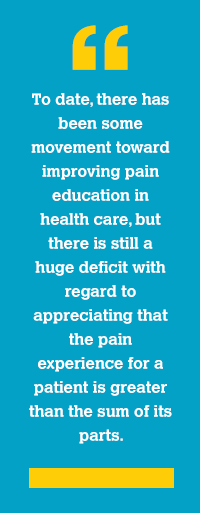 “Integrative pain management is when an individual or institution can move beyond the traditional views of pain as an interpretation or modulation of a nociceptive impulse. Pain evolves not only from tissue damaging stimuli, but may also serve as a consequence of the way stress, sleep, and central autonomic nervous system tone impact brain function. Pain is a complex phenomenon that is mediated through mechanisms that involve more than the traditional views of tissue damage. These traditional views of aligning pain only with tissue damaging stimuli are limiting and may be the driving force behind economic costs associated with the treatment of pain to be estimated at $560-635 billion annually.”
“Integrative pain management is when an individual or institution can move beyond the traditional views of pain as an interpretation or modulation of a nociceptive impulse. Pain evolves not only from tissue damaging stimuli, but may also serve as a consequence of the way stress, sleep, and central autonomic nervous system tone impact brain function. Pain is a complex phenomenon that is mediated through mechanisms that involve more than the traditional views of tissue damage. These traditional views of aligning pain only with tissue damaging stimuli are limiting and may be the driving force behind economic costs associated with the treatment of pain to be estimated at $560-635 billion annually.”
“In 2011, the Institute of Medicine (IOM) recommended the government support substantial improvements in patient and professional education regarding pain. This recommendation included both undergraduate and graduate curricula change to improve pain management education for all health care professionals. To date, there has been some movement toward improving pain education in health care, but there is still a huge deficit with regard to appreciating that the pain experience for a patient is greater than the sum of its parts.”
Click button below to read more about this program, anticipated to greatly improve the quality of life and access to pain management to underserved patients in rural communities.
Duke Releases Case Study on Comprehensive Pain Program Using Unique Bundled Payment Arrangement
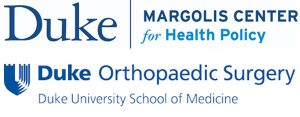 AACIPM is pleased to share that the Duke-Margolis Center for Health Policy and the Duke Department of Orthopaedic Surgery have released the second of four case studies emanating from their 2020-21 Roundtable on Integrated Pain Management. Their second case study features the University of Vermont Medical Center’s Comprehensive Pain Program (CPP), which was established in 2017 to improve treatment options for patients struggling with opioid use for musculoskeletal pain conditions. The program developed a customized intensive outpatient program that includes an array of integrative therapies to optimize patients’ function and maximize their well-being, supported by a unique bundled payment arrangement developed in partnership with Blue Cross and Blue Shield of Vermont. The case study details the program’s novel bundled payment arrangement, highlights the program’s history and implementation, and describes key factors that have contributed to the program’s success. Duke will be releasing the remaining two case studies in the coming months.
AACIPM is pleased to share that the Duke-Margolis Center for Health Policy and the Duke Department of Orthopaedic Surgery have released the second of four case studies emanating from their 2020-21 Roundtable on Integrated Pain Management. Their second case study features the University of Vermont Medical Center’s Comprehensive Pain Program (CPP), which was established in 2017 to improve treatment options for patients struggling with opioid use for musculoskeletal pain conditions. The program developed a customized intensive outpatient program that includes an array of integrative therapies to optimize patients’ function and maximize their well-being, supported by a unique bundled payment arrangement developed in partnership with Blue Cross and Blue Shield of Vermont. The case study details the program’s novel bundled payment arrangement, highlights the program’s history and implementation, and describes key factors that have contributed to the program’s success. Duke will be releasing the remaining two case studies in the coming months.
Duke’s in-person Roundtable that spurred the creation of this series of case studies took place in February 2020 and included participation from numerous AACIPM leaders and experts. Further background on this Roundtable can be found on Duke’s website and AACIPM’s website, including reflections from AACIPM’s Advisory Committee member, Adam Seidner, MD, MPH, Chief Medical Officer, The Hartford.
National Updates from Congress and HHS
 CARA 3.0 Begins Long Journey Toward Passage
CARA 3.0 Begins Long Journey Toward Passage
The House of Representatives has begun work on the third iteration of the Comprehensive Addiction and Recovery Act, known this time around as the CARA 3.0 Act of 2021. The House introduced CARA 3.0, also known as HR 4341, in July, and the bill already has 47 cosponsors and has been referred simultaneously to six different committees for consideration. While the Senate introduced their own version of CARA 3.0 (S 987) in March, almost no action has been taken on that version of the bill.
NIH HEAL Initiative Introduces New Community Partner Committee
A subcommittee of Multidisciplinary Working Group
 The NIH HEAL Initiative, a trans-NIH effort to improve prevention and treatment strategies for opioid misuse and addiction and to enhance pain management, has announced the creation of the HEAL Community Partner Committee made up of people with lived experience, advocates, and/or family members of someone with pain or addiction. A subcommittee of the HEAL Multidisciplinary Working Group, who advises the initiative on research directions and activities, the new committee will provide input on key issues faced by individuals affected by pain conditions or opioid use disorder to ensure the relevance and generalizability of HEAL-supported research.
The NIH HEAL Initiative, a trans-NIH effort to improve prevention and treatment strategies for opioid misuse and addiction and to enhance pain management, has announced the creation of the HEAL Community Partner Committee made up of people with lived experience, advocates, and/or family members of someone with pain or addiction. A subcommittee of the HEAL Multidisciplinary Working Group, who advises the initiative on research directions and activities, the new committee will provide input on key issues faced by individuals affected by pain conditions or opioid use disorder to ensure the relevance and generalizability of HEAL-supported research.
The Community Partner Committee includes Christin Veasley of the Chronic Pain Research Alliance, a long-time AACIPM partner, as well as representatives from Family and Medical Counseling Services, the Addiction Policy Forum, the Georgia Council on Substance Abuse, Faces & Voices of Recovery, and two additional advocates representing people living with pain.
NIH HEAL Initiative Multi-Disciplinary Working Group Meets September 1-2
On September 1 and 2, the NIH HEAL Initiative will convene a meeting of the Multi-Disciplinary Working Group (MDWG) to share updates, progress, and activities of the initiative, as well as trends in opioid misuse, overdose, and addiction. A discussion with members of the MDWG will follow these presentations.
A videocast link will be available to view the open session of the meeting on September 1 (day 1). Please visit the NIH HEAL Initiative website for the meeting agenda and videocast link.
NAM Releases Podcast on Racism and the American Opioid Epidemic
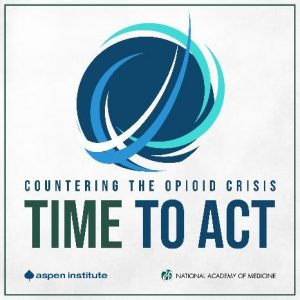 Aimed at combatting the fractured approach to addressing the opioid crisis, which often targets small portions of the crisis rather than taking a holistic view, the National Academy of Medicine and the Aspen Institute launched the Action Collaborative on Countering the U.S. Opioid Epidemic in early 2021. Through convenings, publications, strategic partnerships, webinars, this podcast, and other outlets the experts who comprise the Action Collaborative aim to uplift established evidence, promote best practices, identify research gaps, and identify collaborative approaches to countering the opioid crisis. In August, the Collaborative focused on the intersection of systemic racism, policy, and healthcare. Previous episodes have explored the interplay between the opioid epidemic and COVID-19 pandemic and the role of stigma in treating substance use disorder. You will find the audio podcasts, as well as written transcripts, here.
Aimed at combatting the fractured approach to addressing the opioid crisis, which often targets small portions of the crisis rather than taking a holistic view, the National Academy of Medicine and the Aspen Institute launched the Action Collaborative on Countering the U.S. Opioid Epidemic in early 2021. Through convenings, publications, strategic partnerships, webinars, this podcast, and other outlets the experts who comprise the Action Collaborative aim to uplift established evidence, promote best practices, identify research gaps, and identify collaborative approaches to countering the opioid crisis. In August, the Collaborative focused on the intersection of systemic racism, policy, and healthcare. Previous episodes have explored the interplay between the opioid epidemic and COVID-19 pandemic and the role of stigma in treating substance use disorder. You will find the audio podcasts, as well as written transcripts, here.
CMS Still Accepting Comments on 2022 Physician Fee Schedule
 As announced last month, the Centers for Medicare & Medicaid Services (CMS) issued a proposed rule outlining changes to the Medicare Physician Fee Schedule (PFS) and other Medicare Part B payments for Calendar Year (CY) 2022. The proposed rule contains many pain-specific provisions and presents an exciting opportunity for advocates to provide information that could substantially impact CMS payment structure in regard to pain management. Comments to the proposed rule change will be accepted through September 13, 2021.
As announced last month, the Centers for Medicare & Medicaid Services (CMS) issued a proposed rule outlining changes to the Medicare Physician Fee Schedule (PFS) and other Medicare Part B payments for Calendar Year (CY) 2022. The proposed rule contains many pain-specific provisions and presents an exciting opportunity for advocates to provide information that could substantially impact CMS payment structure in regard to pain management. Comments to the proposed rule change will be accepted through September 13, 2021.
AACIPM is currently drafting a group sign-on response to this proposal, coordinating with the many groups and individuals who expressed interest after receiving our initial alert. If you have interest in reviewing and signing on to our letter, please contact Amy Goldstein no later than September 6th.
Partner Educational Opportunities
New Study Proves Benefits of Teaching Patients Self Care, Provider Education Available
 A recent study of 263 adults with chronic low-back pain has shown that patients who take a single 2-hour pain relief skills class show clinically meaningful reductions in pain catastrophizing scores at their three-month follow-up visits. The course, Empowered Relief™, includes pain neuroscience education, mindfulness principles, and CBT skills (identifying distressing thoughts and emotions, cognitive reframing, a relaxation response exercise, and a self-soothing action plan).
A recent study of 263 adults with chronic low-back pain has shown that patients who take a single 2-hour pain relief skills class show clinically meaningful reductions in pain catastrophizing scores at their three-month follow-up visits. The course, Empowered Relief™, includes pain neuroscience education, mindfulness principles, and CBT skills (identifying distressing thoughts and emotions, cognitive reframing, a relaxation response exercise, and a self-soothing action plan).
Empowered Relief™ is an evidence-based, single-session pain class that rapidly equip patients with self-care pain management skills. An online workshop will be held on October 8-9, 2021 to certify practitioners to provide this type of patient education. Developed by pain psychologist Beth Darnall, PhD, this program has been embedded into clinical care pathways at Stanford University since 2013 and was recently expanded after initial successes thanks to funding from the National Institutes of Health. The program is open to clinicians of all disciplines and is intended to enable participants to immediately implement their new skills into their clinic or research study.
Register for the October 8-9 workshop.
MassPI to Hold Pain Education Webinar on Today’s Changing Tide
 On October 14, 2021, MassPI will hold their fall pain education webinar, Steering the Course of Pain Management in Today’s Changing Tide. Featuring Keynote Speaker Lynn Webster, MD, in addition to experts focusing on opioid moderatism, pathways for innovation in pain treatment, and leveraging technology to enhance equitable access, the conference offers four nationally certified continuing education credits to physicians, nurses, pharmacists, psychologists, and social workers.
On October 14, 2021, MassPI will hold their fall pain education webinar, Steering the Course of Pain Management in Today’s Changing Tide. Featuring Keynote Speaker Lynn Webster, MD, in addition to experts focusing on opioid moderatism, pathways for innovation in pain treatment, and leveraging technology to enhance equitable access, the conference offers four nationally certified continuing education credits to physicians, nurses, pharmacists, psychologists, and social workers.
Register here for the October 14 webinar.
AIHM Wellness Webinar – Whole Body Approach to Low Back Pain
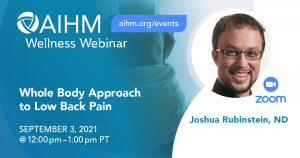 On September 3, AIHM will present Whole Body Approach to Low Back Pain, from their Wellness Webinar series. Joshua Rubinstein, MD, Clinical Sciences chair of the naturopathic medicine program at Bastyr University, will look at some of the major factors contributing to low back pain. This will include an overview of some of the major biomechanical and postural reasons folks develop low back pain. Dr. Rubinstein will review some of the major exercises he recommends to address these contributing factors. We will also look at nutritional strategies to support connective tissue (joints and skin) throughout the body.
On September 3, AIHM will present Whole Body Approach to Low Back Pain, from their Wellness Webinar series. Joshua Rubinstein, MD, Clinical Sciences chair of the naturopathic medicine program at Bastyr University, will look at some of the major factors contributing to low back pain. This will include an overview of some of the major biomechanical and postural reasons folks develop low back pain. Dr. Rubinstein will review some of the major exercises he recommends to address these contributing factors. We will also look at nutritional strategies to support connective tissue (joints and skin) throughout the body.
Register for free for the September 3 webinar.
Message from the Director

I hope this issue finds everyone well as many of us are experiencing back to school along with the busy transition into an even busier fall calendar.
I am really excited for AACIPM to be sharing our focus on Pain and Self Care Awareness Month in September – and beyond. Most of us engaged with AACIPM understand that health care includes self care. It’s not something separate but is becoming increasingly more understood as part of Whole Health Care.
Our aim is to do what we’ve always done best – Connect the Dots! There are so many evidence-informed self management activities for pain, and there are more and more examples in program and payment designs showing the efficacy and value of this approach to care for people with pain.
Join us in our efforts to bridge deeper understanding and build awareness across the many stakeholders invested in whole person, comprehensive integrative pain management. You can do this by registering for the Sept. 28 webinar with Midwest Business Group on Health (see the first entry above), and watching your inbox for more additions to the repository for pain and self care on our website (under development). We’ll also be at IM4US 2021 on Sept. 24, co-moderating an amazing panel, titled, Advancing Integrative Pain Management Through Collaboration and Advocacy.
Onward and Upward!
Amy
Relevant Reading
![]()
This Drug Helped My Chronic Pain – But It’s Also Killing People, Vice, August 26
How to Exercise for Psoriatic Arthritis Pain Relief, Self, August 25
Association Between Sleep Quality and Pain Intensity in Mild Patients with COPD: A Community Study, DovePress, August 25
Psychosocial and cardiometabolic predictors of chronic pain onset in Native Americans, Pain, August 24
The pain switch, MIT Technology Review, August 24
Delta opioid receptor regulation of calcitonin gene–related peptide dynamics in the trigeminal complex, PAIN, August 2021
Psychotropic Medications May Significantly Reduce Chronic Pain in Pediatric Patients, Clinical Pain Advisor, August 19
CME – Fibromyalgia: What It Is and How to Treat It, Psychiatric Times, August 18
Efficacy of Acupuncture for Chronic Prostatitis/Chronic Pelvic Pain Syndrome, Annals of Internal Medicine, August 17
The Pain Medicine Fellowship Telehealth Education Collaborative, Pain Medicine, August 17
Chronic Pain Among Service Members, Rand Corp., August
Pain Perception Training May Help With Back Pain in Hypermobile EDS, Ehlers-Danlos News, August 9
Why Migraine Sufferers May Want to Eat More Fish, New York Times, August 7
4 Things the Chronically Ill Wish Others Understood, Psychology Today, August 5
Hierarchical clustering by patient-reported pain distribution alone identifies distinct chronic pain subgroups differing by pain intensity, quality, and clinical outcomes, PLOS One, August 4
Chronic pain sufferers silenced by pandemic, Hippocratic Post, August 3
CDC Opioid Prescribing Guideline Updates Are in the Works: Will the Changes be Enough?, Practical Pain Management, August 3
Peripheral nerve stimulation for chronic low back pain may reduce pain, disability, Orthopedics Today, August 2
Association between widespread pain and dementia, Alzheimer’s disease and stroke: a cohort study from the Framingham Heart Study, Regional Anesthesia & Pain Medicine, August 2
Women’s chronic pain is often dismissed as being ‘dramatic’ – which can ruin health and lives, Insider, July 31
Study: 7 in 10 chronic pain sufferers delayed seeking medical advice during the pandemic, News Medical Life Sciences, July 31
90% of US primary care offers lower pain relief doses to Black patients, Medical News Today, July 30
What to Expect in Thoracic Outlet Syndrome Physical Therapy, Very Well Health, July 30
90% of US primary care offers lower pain relief doses to Black patients, Medical News Today, July 30
How Virtual Reality Is About to Revolutionize Healthcare, Bloomberg, July 30
Podcast: HOW TO COMBINE PAIN NEUROSCIENCE WITH YOGA FOR EFFECTIVE PAIN CARE WITH NIAMH MOLONEY, PHD, PT AND MARNIE HARTMAN, DPT, RYT, Integrative Pain Science Institute, July 30
Patient Preference and Risk Assessment in Opioid Prescribing Disparities, JAMA Netw Open, July 29
US service members suffer chronic pain at rate much higher than civilian population, report says, Stars and Stripes, July 6
Feedback
We welcome your input! What do you like? Do you have a contribution for an upcoming newsletter? Send us your comments, suggestions, or contributions.

